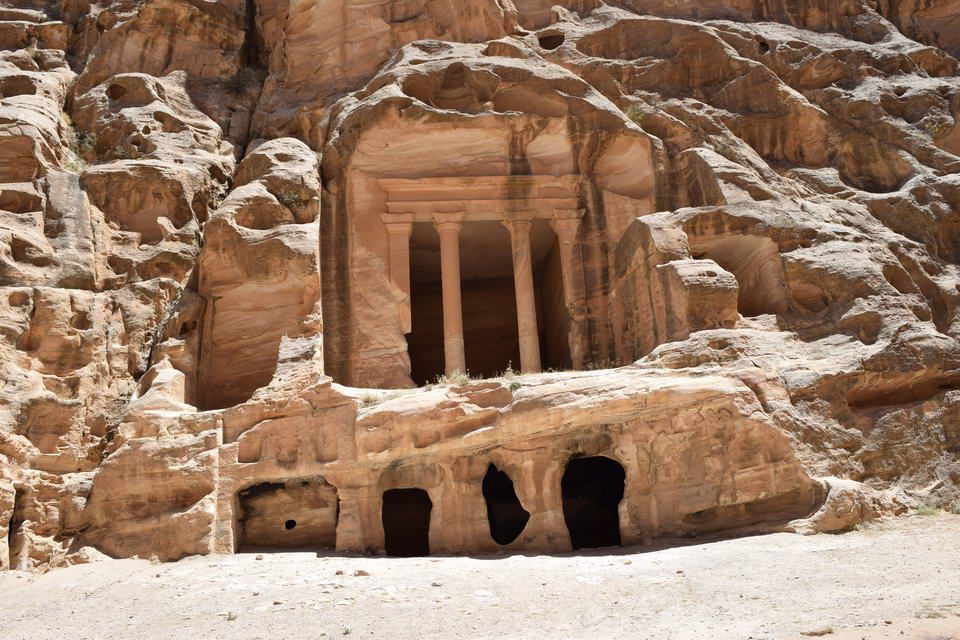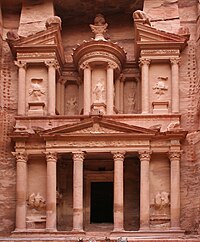Exploring Little Petra: The Smaller, But Just as Spectacular, Sister of Petra
Hidden deep within the desert of modern-day Jordan, an ancient city carved into sandstone cliffs awaits exploration. While the world-famous Petra tends to steal the spotlight, its smaller yet equally breathtaking sister, Little Petra, should not be overlooked. With impressive rock-cut structures, stunning views of the mountainous landscape, and far fewer crowds, Little Petra offers a unique and immersive experience for travellers seeking a deeper connection with Jordan's rich history.
In this blog post, we'll delve into all you need to know about visiting Little Petra, including practical information, must-see attractions, and tips for a memorable visit. So, get ready to step back in time and uncover the wonders of this hidden gem.

Introduction to Little Petra
Little Petra's Significance and historical background
Little Petra, also known as Siq Al-Barid, is a smaller but equally spectacular sister site to the famous archaeological site of Petra in Jordan. While it may not be as well-known as Petra, Little Petra holds significant historical and cultural value.
Historically, Little Petra served as an important trading outpost and resting place for the Nabateans, a civilization that thrived in the region from the 4th century BC to the 2nd century AD. The Nabateans were skilled builders and traders, and their influence can be seen in Little Petra's intricate architecture and carvings.
Like Petra, Little Petra features a narrow canyon known as the Siq, leading to a collection of ancient structures carved into the sandstone cliffs. The Siq Al-Barid offers a glimpse into the daily life of the Nabateans with its well-preserved facades, tombs, and water channels.
One of the notable features of Little Petra is the Painted House, a well-preserved structure adorned with colourful frescoes depicting animals, plants, and human figures. These frescoes provide valuable insights into the artistic and cultural practices of the Nabateans.
Another highlight of Little Petra is the Obelisk Tomb, an impressive burial site featuring a towering obelisk-like structure carved into the rock face. The facade of the tomb is adorned with intricate engravings and is a testament to the architectural skills of the Nabateans.
Little Petra offers a unique opportunity to explore the Nabatean civilisation's rich history and architectural marvels, providing a deeper understanding of the region's ancient past. Whether visiting as a standalone destination or as an extension of a trip to Petra, Little Petra is a must-see for history enthusiasts and travellers seeking a more intimate experience in this remarkable part of the world.

How Little Petra connects to the larger Petra archaeological site
Little Petra, also known as Siq al-Barid, is often called the smaller but just as spectacular sister of Petra. This ancient archaeological site is located just a few kilometers north of Petra and shares many similarities with its larger counterpart.
Like the main Petra site, little Petra served as an important caravan stop and trade hub during the Nabatean period. It is believed to have been a suburb of Petra and functioned as an entry point for travellers and merchants from the north.
One of the most significant ways Little Petra connects to the larger Petra site is through a narrow, rock-cut passage known as the Siq al-Barid, or the Outer Siq. This pathway resembles the iconic Siq in Petra, albeit on a smaller scale. Walking through the Siq al-Barid gives visitors a taste of the awe-inspiring experience that awaits them at Petra.
Exploring Little Petra provides a unique opportunity to see the architectural and artistic styles of the Nabateans up close. The cave tombs in Little Petra bear similarities to those found in Petra, showcasing intricate carvings and stunning architectural details.
While Little Petra may be smaller, it offers a glimpse into the rich history and grandeur of the Nabatean civilization. Visiting both Little Petra and Petra allows travellers to fully appreciate the cultural heritage of this ancient civilization and marvel at the architectural wonders they left behind.
Little Petra is a must-visit destination for those interested in Petra and the Nabateans. Its proximity to the larger Petra site and its connections to the wider Nabatean civilization make it a fascinating and rewarding experience for history buffs and travellers.

The Siq Al-Berid (The Outer Siq)
Features and characteristics of the Siq Al-Berid
The Siq Al-Berid, also known as the Outer Siq, is one of the key attractions in Little Petra. This narrow ancient rock passage stretches for about 350 meters and is similar in structure to the famous Siq in Petra.
The Siq Al-Berid provides a sense of awe as you walk through its towering cliffs. The sandstone walls showcase beautiful patterns and colours, varying from warm hues of red and orange to cool shades of pink and white. The walls' natural formations and geological layers are a sight to behold.
One of the main architectural highlights in the Siq Al-Berid is the carved water channels. These channels would have directed water from the surrounding mountains into the city, ensuring a reliable water supply for the inhabitants. The clever engineering and craftsmanship that went into creating these water channels are impressive.
As you wander through the Siq Al-Berid, you'll also come across ancient structures, including rooms and small caves carved into the rock. These structures were likely used as dwellings or storage areas by the Nabateans who inhabited the area.
Overall, the Siq Al-Berid is a must-visit for anyone exploring Little Petra. Its natural beauty, architectural features, and historical significance make it a captivating destination for history enthusiasts and adventure seekers.
Here are some key features and characteristics of the Siq Al-Berid:
- Narrow passage with towering cliffs
- Sandstone walls displaying various colours and patterns
- Carved water channels for irrigation purposes
- Ancient structures such as rooms and caves carved into the rock
So, don't miss the opportunity to explore the Siq Al-Berid and experience the wonder of Little Petra!

Architectural highlights and ancient structures in the area
One of the remarkable features of Little Petra is the abundance of architectural highlights and ancient structures in the area. These structures showcase the skilled craftsmanship of the Nabateans and offer a glimpse into their rich history and culture. Here are some of the highlights:
-
The Triclinium: This well-preserved structure was a banquet hall in ancient times. It features three carved-out rock platforms where guests recline while enjoying their meals. The Triclinium also boasts intricately carved decorations and columns.
-
The Palace Tomb: As its name suggests, this tomb has a palatial appearance with its grand façade and impressive architecture. The Palace Tomb is adorned with decorative elements, including carved pilasters and a frieze depicting warriors.
-
The Garden Triclinium: This structure is unique, featuring a central courtyard surrounded by rooms with arched entrances. It is believed to have served as travellers' meeting place or a resting area.
-
The Renaissance Tomb stands out for its monumental size and elaborate decoration. It showcases a mix of Nabatean and Roman architectural styles, with columns, pediments, and intricately carved reliefs.
-
The Cave of the Painted Eye: As its name suggests, this cave contains an eye-catching painting on one of its ceilings. The vivid colours and intricate details of the painting serve as a testament to the artistic abilities of the Nabateans.
Visiting these architectural wonders in Little Petra provides a fascinating insight into the ancient Nabatean civilisation's advanced engineering and artistic skills. It is a must-visit destination for history buffs and those seeking to explore the hidden gems of Jordan.

Nabatean Cave Tombs
Exploring the cave tombs in Little Petra
Exploring the cave tombs in Little Petra is like stepping back in time and uncovering the Nabateans' unique burial practices and artistry. These ancient tombs, carved into the rocky hillsides, are a testament to the rich history and culture of the Nabatean civilization.
One of the most fascinating aspects of these cave tombs is their architectural design. The Nabateans were skilled craftsmen and incorporated intricate details into the facades of the tombs. Elaborate carvings, decorative motifs, and symbolic engravings adorn the entrances, showcasing the artistic prowess of the Nabateans.
Inside the tombs, you can still find remnants of the burial chambers and niches where the deceased were laid to rest. The careful craftsmanship and attention to detail extend to the interiors as well. Many of the tombs feature decorative elements, such as columns and alcoves, adding to the grandeur of the final resting place.
Exploring these ancient tombs provides a glimpse into the lives and beliefs of the Nabateans. It's a chance to witness their reverence for the afterlife and their dedication to preserving the memory of the deceased.
Here are some key highlights of exploring the cave tombs in Little Petra:
- Witness the intricate architectural details on the facades of the tombs.
- Explore the well-preserved burial chambers and niches inside the tombs.
- Appreciate the symbolic engravings and decorative elements that adorn the interiors.
- Gain insights into the Nabatean culture and their beliefs surrounding death and the afterlife.
Visiting the cave tombs in Little Petra offers a truly immersive experience of the fascinating world of the Nabateans, and it's a must-see for any history enthusiast or archaeology lover.

Uncovering the unique burial practices and artistry of the Nabateans
When exploring Little Petra, it's fascinating to uncover the Nabateans' unique burial practices and artistry - the ancient civilization that inhabited this area. The Nabateans had a distinctive way of honouring their deceased, which is evident in the cave tombs found in Little Petra. These tombs were carved out of the soft sandstone cliffs and were the final resting places for the Nabatean elite.
Intricate carvings and decorations can be found inside the cave tombs, showcasing the fine craftsmanship and skill of the Nabatean artisans. The walls are adorned with beautiful, detailed reliefs depicting images of animals, plants, and mythological figures. These artistic expressions not only reflect the cultural and religious beliefs of the Nabateans but also give us a glimpse into their daily lives.
One of the most intriguing aspects of the Nabatean burial practices is how they incorporated art into their tombs. The tomb facades often featured elaborately carved reliefs, showcasing symbols and motifs that held significant meaning for the Nabateans. This blending of art and burial practices highlights the importance of aesthetics and symbolism in Nabatean culture.
Visiting the cave tombs in Little Petra allows you to step back in time and appreciate the artistry and creativity of the Nabateans. It's a chance to witness their unique burial practices and better understand their rich history and heritage.
Here's a list summarizing the unique burial practices and artistry of the Nabateans:
- Carved cave tombs in the soft sandstone cliffs
- Intricate carvings and decorations inside the tombs
- Detailed reliefs depicting animals, plants, and mythological figures
- Elaborately carved tomb facades with symbolic motifs
- The blending of art and burial practices in Nabatean culture

The Painted House
Learn about the well-preserved frescoes in the Painted House
Located in the heart of Little Petra, the Painted House is a must-visit site for history and art enthusiasts. This unique structure is renowned for its remarkably well-preserved frescoes, which provide a vivid glimpse into the ancient Nabatean civilization.
The frescoes in the Painted House depict various subjects, including hunting scenes, landscapes, and intricate geometric patterns. The vibrant colours, intricate details, and artistic skill displayed in these paintings leave visitors in awe of the talent and creativity of the Nabateans.
The preservation of these frescoes is truly remarkable, considering they were created over 2,000 years ago. The region's desert climate has played a crucial role in protecting these works of art, allowing them to maintain their original beauty and splendour.
Aside from their aesthetic value, the frescoes in the Painted House also provide valuable insights into the Nabateans' daily life, culture, and beliefs. Through careful examination and interpretation, archaeologists and historians have been able to unravel fascinating details about the Nabatean society and their artistic traditions.
Visiting the Painted House is like stepping back in time and witnessing the talent and creativity of a civilization long gone. It is a humbling and awe-inspiring experience that allows us to appreciate the Nabateans' rich heritage and artistic achievements.
The Painted House in Little Petra is a treasure trove of well-preserved frescoes that offer a unique glimpse into an ancient civilization. Its historical and cultural significance, combined with the remarkable state of preservation, make it a must-see destination for any visitor to the region.

Understanding the cultural and historical importance of this unique structure
The Painted House in Little Petra is a remarkable archaeological site that offers valuable insights into the cultural and historical significance of the Nabateans. This unique structure is adorned with well-preserved frescoes that depict various scenes and motifs from the Nabatean period, providing a glimpse into their artistic and symbolic expressions.
The frescoes in the Painted House not only showcase the artistic skills of the Nabateans but also offer clues about their daily life, beliefs, and cultural practices. The paintings' vibrant colours and intricate details are a testament to the advanced techniques employed by the Nabateans in their artistic endeavours.
Exploring the Painted House allows us to understand the importance of art and visual representation in the Nabatean civilization. The motifs and symbols used in the frescoes can provide valuable insights into their religious beliefs, social hierarchy, and trade connections.
Moreover, the preservation of the frescoes in the Painted House is a testament to the efforts of conservationists and the local community in safeguarding the cultural heritage of Little Petra. It is a reminder of the rich history and cultural diversity in the ancient city of Petra and its surrounding areas.
Visiting the Painted House is an opportunity to immerse oneself in the beauty and significance of Nabatean art and culture. It is a testament to the enduring legacy of the Nabateans and their contribution to the artistic and historical narratives of the ancient world.
Overall, the Painted House in Little Petra offers a captivating journey into the cultural and historical tapestry of the Nabateans, allowing visitors to appreciate their artistic achievements and gain a deeper understanding of their civilization.

Obelisk Tomb
Discover the impressive Obelisk Tomb and its symbolic significance
The Obelisk Tomb in Little Petra is a remarkable structure that showcases the architectural and artistic prowess of the ancient Nabateans. This tomb, named after the four obelisks adorning its facade, is impressive.
Symbolically, the obelisks represent the eternal nature of life and death in Nabatean culture. The obelisks are believed to be markers of the entrance to the afterlife, guiding the deceased into immortality.
The tomb itself is carved into the sandstone cliffs, featuring intricate details and engravings on its facade. The facade is adorned with decorative motifs and reliefs that depict various scenes from Nabatean mythology and daily life. These engravings provide valuable insights into the beliefs and customs of the Nabatean people.
The Obelisk Tomb is a testament to the engineering and artistic skills of the Nabateans, showcasing their ability to create grand structures that combine functionality with beauty. Exploring this tomb allows visitors to immerse themselves in the Nabatean civilisation's rich history and cultural heritage.
With its impressive architecture and symbolic significance, the Obelisk Tomb is a must-visit attraction for anyone exploring the wonders of Little Petra.

Exploring the architectural details and engravings on the facade
The Obelisk Tomb in Little Petra is a sight to behold, with its remarkable architectural details and intricate engravings on the facade. This tomb, carved directly into the rock face, features a tall obelisk-like structure at its entrance, hence its name.
The facade of the Obelisk Tomb is adorned with beautiful geometric patterns, floral motifs, and ornate designs, showcasing the exceptional craftsmanship of the Nabateans. The precision and skill of carving these decorations into the stone are awe-inspiring.
One of the standout features of the tomb is the inscription that can be found above the entrance. This inscription, written in Nabatean script, provides insights into the tomb's occupants and lineage. It is a testament to the importance of the individuals buried within.
As you explore the facade of the Obelisk Tomb, you'll notice the attention to detail in the carvings. Delicate floral motifs intertwine with geometric patterns, creating a visually stunning display. The engravings not only serve as decorative elements but also provide a glimpse into the cultural and artistic sensibilities of the Nabateans.
Visiting the Obelisk Tomb allows you to marvel at the intricate designs and immerse yourself in the rich history and architecture of Little Petra. The engravings on the facade serve as a testament to the remarkable artistic achievements of the Nabateans and offer a glimpse into their ancient civilization.
So, while Little Petra may be smaller than its famous sister site, Petra, it certainly doesn't lack in architectural splendour. The Obelisk Tomb is just one example of the hidden gems waiting to be discovered in this remarkable archaeological site.
